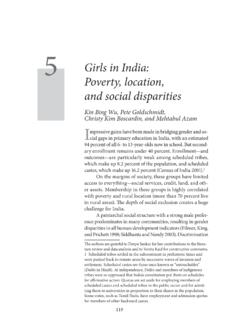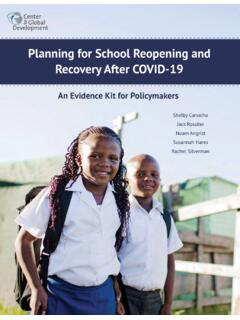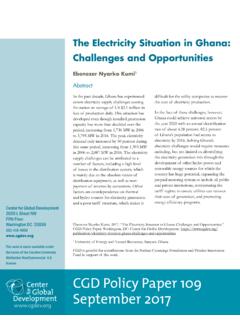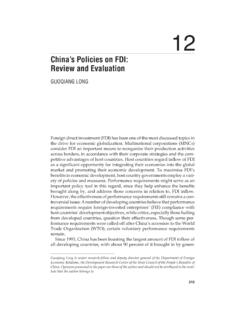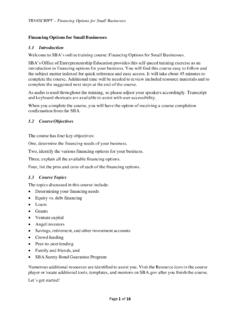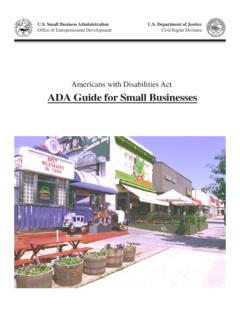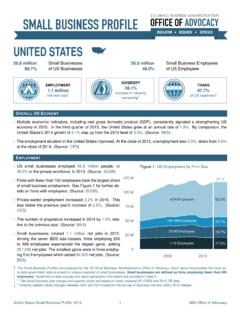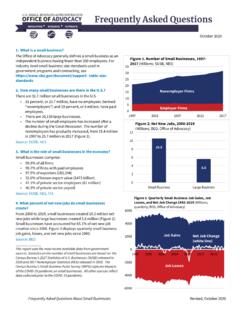Transcription of Impact COVID-19 Small and Medium-Sized Enterprises …
1 Working Paper 549 September 2020 The Impact of COVID-19 on Small and Medium-Sized Enterprises : Evidence from Two-wave Phone Surveys in ChinaAbstractThis paper examines both the short-term and mid-term Impact of COVID-19 restrictions on Small and Medium-Sized Enterprises (SMEs), based on two waves of phone interviews with a previously surveyed large SME sample in China. The outbreak of COVID-19 and resultant lockdowns cast a heavy toll on SMEs. Affected by problems of logistics blocks, labor shortages, and drops in demand, 80 percent of SMEs temporarily closed at the time of the first wave of interviews in February 2020. After reining in COVID-19 , authorities largely eased lockdown restrictions in April. Consequently, most SMEs had reopened by the time of the second round of surveys in May. However, many firms, particularly export firms, ran at partial capacity, primarily due to inadequate demand.
2 Moreover, around 18 percent of SMEs closed for good between the two waves of surveys from February to May, shedding 14 percent of total jobs. Dai, Hao Feng, Junpeng Hu, Quan Jin, Huiwen Li, Ranran Wang, Ruixin Wang, Lihe Xu, and Xiaobo ZhangKeywords: COVID-19 ; SMEs; Chinese economy; lockdown; reopeningCenter for Global Development2055 L Street NWWashington, DC (f) Center for Global Development works to reduce global poverty and improve lives through innovative economic research that drives better policy and practice by the world s top decision makers. Use and dissemination of this Working Paper is encouraged; however, reproduced copies may not be used for commercial purposes. Further usage is permitted under the terms of the Creative Commons views expressed in CGD Working Papers are those of the authors and should not be attributed to the board of directors, funders of the Center for Global Development, or the authors respective Impact of COVID-19 on Small and Medium-Sized Enterprises (SMEs).
3 Evidence from Two-wave Phone Surveys in ChinaRuochen Dai Central University of Finance and EconomicsHao Feng Shanghai University of International Business and EconomicsJunpeng HuPeking UniversityQuan JinShanghai University of International Business and EconomicsHuiwen LiShanghai University of International Business and EconomicsRanran WangPeking UniversityRuixin WangHarbin Institute of Technology at ShenzhenLihe Xu Guangdong University of Foreign StudiesXiaobo Zhang Peking University; IFPRI; and Visiting Fellow, Center for Global DevelopmentThe Center for Global Development is grateful for contributions from the Ford Foundation in support of this work. The authors are also grateful for the support from a special grant for studying the Impact of COVID-19 from Peking University and a research grant from China Natural Science Foundation (#71874008).
4 The Policies, Institutions, and Markets (PIM) research program of the International Food Policy Research Institute (IFPRI) also provided support for this research. Many team members from the Enterprise Survey for Innovation and Entrepreneurship in China (ESIEC) Project Alliance (formed by Peking University, Central University of Finance and Economics, Harbin Institute of Technology at Shenzhen, Guangdong University of Foreign Studies, and Shanghai University of International Business and Economics), including but not limited to Zijun Cheng, Shuo Liu, Yingyue Quan, Shan Wu, and Yunfei Zhang, were involved in the survey implementation and data analysis. We are grateful for their great contributions. Finally, we thank enthusiastic enumerators for conducting the surveys and entrepreneurs for patiently accepting our interviews Ruochen Dai, Junpeng Hu, and Xiaobo Zhang, et al.
5 2020. The Impact of COVID-19 on Small and Medium-Sized Enterprises (SMEs): Evidence from Two-wave Phone Surveys in China. CGD Working Paper 549. Washington, DC: Center for Global Development. Center for Global Development2055 L Street NWWashington, DC (f) Center for Global Development works to reduce global poverty and improve lives through innovative economic research that drives better policy and practice by the world s top decision makers. Use and dissemination of this Working Paper is encouraged; however, reproduced copies may not be used for commercial purposes. Further usage is permitted under the terms of the Creative Commons views expressed in CGD Working Papers are those of the authors and should not be attributed to the board of directors, funders of the Center for Global Development, or the authors respective organizations.
6 Contents 1. 1 2. Survey Description .. 2 3. Reopening Status and Prospects for the Remainder of 2020 .. 4 4. Evolving Major Challenges .. 6 Major Challenges in February .. 6 Major Challenge in May: Lack of Demand .. 7 Challenges Facing Export Firms .. 7 5. Financial Challenges and Bankruptcy .. 8 6. Conclusions .. 10 References .. 11 Appendix A .. 22 1 1. Introduction Business activity in China, the world s second-largest economy, ground to a halt for a few months after the outbreak of COVID-19 in China in January 2020. Tens of millions of Small and Medium-Sized Enterprises (SMEs) were shut down. Given that SMEs generate 80 percent of employment, it is important to understand the toll the novel coronavirus is taking on SMEs, in order to ensure that policy measures are appropriately designed to meet their needs.
7 However, gauging the Impact of COVID-19 on SMEs is particularly challenging because these Enterprises are plentiful in number but Small in size. Unlike publicly listed firms, information on SMEs is scarce. The spread of the virus has made it impossible to physically survey the SMEs. One way to circumvent this challenge is to conduct online surveys. Right after the outbreak of COVID-19 in China, a few online surveys (Zhu, Liu, and Wei, 2020) were conducted to measure the Impact of the novel coronavirus on Chinese firms. Online surveys possess a key advantage in quickly gathering data. However, these surveys are subject to two selection problems (Wang et al., 2020). The first is that the representativeness of the sample is largely unknown and sometimes skewed. It is common for researchers, for instance, to spread the word about online surveys through their own networks, such as university alumni associations.
8 In this case, the respondents were naturally more educated than a typical owner of a SME. The second selection problem with online surveys is that they tend to appeal to certain sectors. In this case, that sector included those entrepreneurs who really suffered from the negative shock of COVID-19 and hence were more likely to spend time answering the online survey questionnaires than those who fared better. Therefore, online surveys tend to report more pessimistic views. To better measure the short-term and mid-term Impact of COVID-19 on SMEs, the Enterprise Survey for Innovation and Entrepreneurship in China (ESIEC) team, led by Peking University, conducted two rounds of follow-up phone interviews in February and May 2020 with previously sampled SMEs in seven provinces, which are largely representative at the provincial level and the major industrial level for China as a whole.
9 The phone interviews asked entrepreneurs about the operational status, major challenges, and business outlook of their businesses as well as their feelings about COVID-19 . The rapid telephone interviews, in combination with the baseline survey, provide us with rich and timely information to study the Impact of COVID-19 on SMEs. Our survey shows that COVID-19 cast a heavy toll on SMEs. At the time of the first wave of phone interviews in February 2020, although most provincial governments allowed businesses to reopen, often with stringent conditions, only about 20 percent of SMEs resumed production. Fourteen percent of surveyed firms would be unable to last beyond a month with their current cash flow, while 50 percent would not survive beyond three months. Nearly half of SMEs did not expect their businesses to reopen within a month or were uncertain about the timing of reopening.
10 From the findings of our survey, it is expected that 16 percent of SMEs would run out of cash before their expected business reopening date. SMEs were struggling with many challenges, such as disruptions in logistics, restrictions on labor mobility, and declines in market order. The major challenges varied by industry. For example, export firms suffered more than others, due to a decline in external demand and a lack of key parts that kept them afloat. SMES in the residential service sector were hit particularly hard because of shrinking demand. Agricultural Enterprises reported more problems with logistical disruptions. 2 After reining in COVID-19 , authorities largely eased lockdown restrictions in April. As a result, most SMEs had reopened by the time of our second round of surveys in May. While the supply-side challenges faded away, lack of demand emerged as the dominant challenge.

